Last updated: 24th October 2021
With the help of some awesome travel bloggers and in no particular order, we’ve put together a list of 15 different UNESCO World Heritage Sites around the world you should consider visiting.
Table of Contents
About UNESCO
UNESCO – The United Nations Educational, Scientific and Cultural Organisation awards World Heritage status to places all over the world. To make it on the list, sites must offer something unique – “geographically, historically or cultural … and have an outstanding contribution”.
15 UNESCO World Heritage Sites
1. Georgetown – Malaysia

Georgetown street art in Penang, Malaysia
By Kelly from Trippin’ Turpins – Full-time travellers and sailors.
The UNESCO listed city of Georgetown, in Penang, was the first British port established along the Malacca Strait. Founded by Captain Francis Light in 1786, Georgetown is a testimony to centuries of maritime history and multi-cultural heritage. Traders from along the India-China trade route began to settle Georgetown, bringing with them their traditions, religions, ideals and architecture that make Georgetown the exciting, heterogeneous city that it is today!
One of my favourite features of Georgetown is the eclectic array of architectural designs. Simply wander the convoluting streets of Georgetown amidst old colonial buildings, Chinese shophouses, Hindu temples and Muslim mosques. Visit Little India with its ‘Bollywood’ music, colourful saris and the aroma of pungent curries; or a few streets over Armenia street is a delight of Chinese lanterns, trishaws, arts, crafts, and souvenir shops. There is simply something for everyone in George Town – colonial, Chinese, Indian and Malay history, museums, markets, and multi-cultural food exploration!
Georgetown has become renown for its street art. The art, a relatively new addition to this charming historical town, is now a prominent tourist drawcard. As well as artistic wall murals there is a series of 52 metal caricatures depicting the area’s history with humorous illustrations and historical facts. You will not regret a day spent following the art trail through the colourful streets of Georgetown!
2. Bellinzona – Switzerland
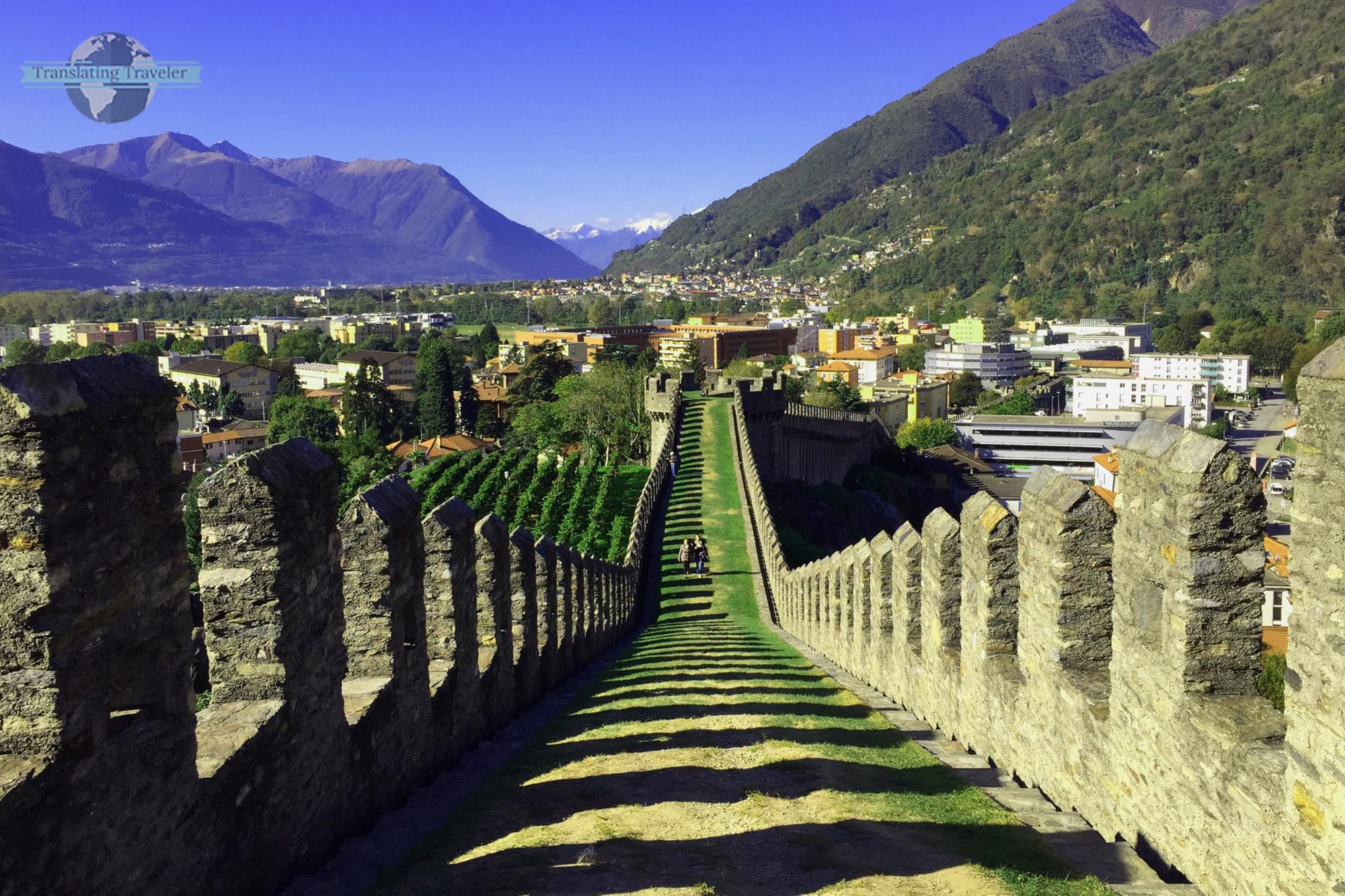
Fortified walls of Castelgrande, Italy
By Chantal, the traveling language geek from Translating Traveler
The quaint little town of Bellinzona is the capital of the Ticino, the southernmost and only Italian-speaking canton of Switzerland. While the pretty little town is already a sight on its own, what makes it truly exceptional is the fact that it has not just one, not two, but three castles. That’s one castle per 6.000 inhabitants!
The three castles Castelgrande, Montebello and Sasso Corbaro have been an UNESCO world heritage site since 2000. All three castles have an incredibly long and fascinating history dating back to the 13th hundreds. The site of the oldest and biggest castle, Castelgrande, however, beats everything. It has been fortified for more than two millennia with structures dating back to at least the 1st century BC!
While all three castles are worth a visit, Castelgrande is definitely the one that shouludn’t be missed. It’s easily reached from Bellinzona’s city center either via a modern elevator or by walking up the fortified walls. Entry is completely free of charge and you only have to pay 5 Francs if you want to climb the tower and see the museum inside. Previously, the castle ground was full of buildings but nowadays, it’s a flat open space that seems to be a favorite among the locals to hang out and enjoy the 250 days of sunshine.
Some of the highlights are the ramparts that connect Castelgrande to Montebello, the stunning view over the Ticino valley with the Alps in the background and the main castle ground of Castelgrande where you can see all three castles at once!
3. Teotihuacan – Mexico
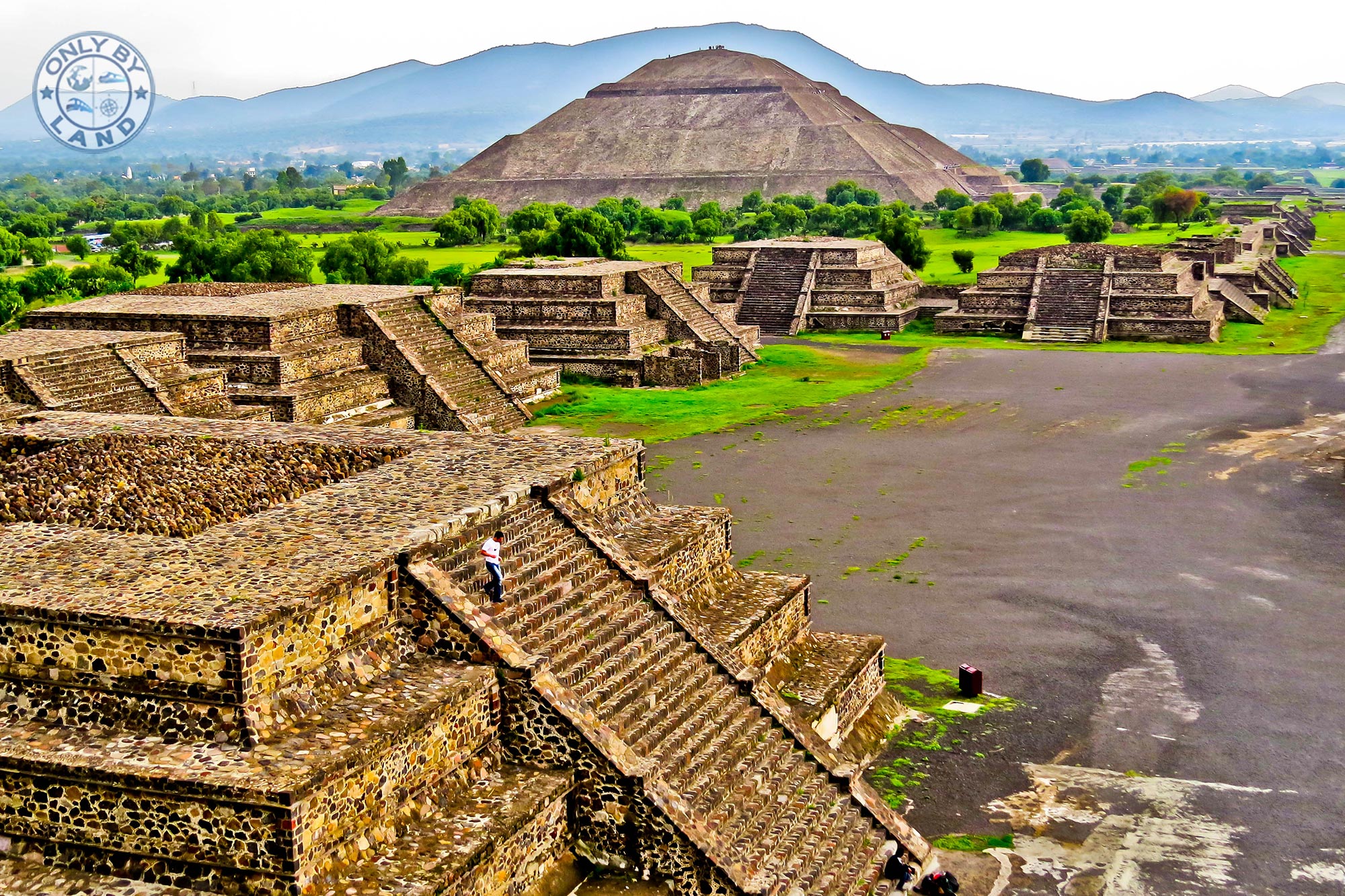
Pyramid of the sun, Teotihuacan, Mexico
By James, who travels Only By Land
For those of you brave enough to visit Mexico City, there’s a reward waiting for you a short drive away. The reward is the UNESCO world heritage site of Teotihuacan. Teotihuacan means ‘Place of the Gods’ in Aztec language.
The Aztecs found the city abandoned and gave it the name Teotihuacan but it actually dates back as far as 200 BC. In 500 AD, around a thousand years before the Aztecs discovered Teotihuacan, it was one of the biggest cities in the world. Despite this fact, the original name still remains unknown. You can find out more about the history of Teotihuacan at the onsite museum.
The 3.2 km long main road through the center of the city is known as the avenue of the dead. The first point of interest on the avenue of the dead is the Temple of Quetzalcotyl, translated as the Temple of the Feathered Serpent.
The centerpiece of Teotihuacan is the pyramid of the sun, one of the largest pyramids in the world. It’s forbidden to climb most pyramids around the world but not here in Teotihuacan, it’s possible to ascend steeply 70 meters all the way to the top.
At the far end of the avenue of the dead you’ll find another large pyramid called the pyramid of the moon. You cannot reach the top of this one but it’s possible to ascend half way up. From here you’ll get great photos of the plaza, the pyramid of the sun, the avenue of the dead and all of the smaller pyramids.
Organized day trips leave to Teotihuacan from Mexico City daily.
4. Cusco – Peru
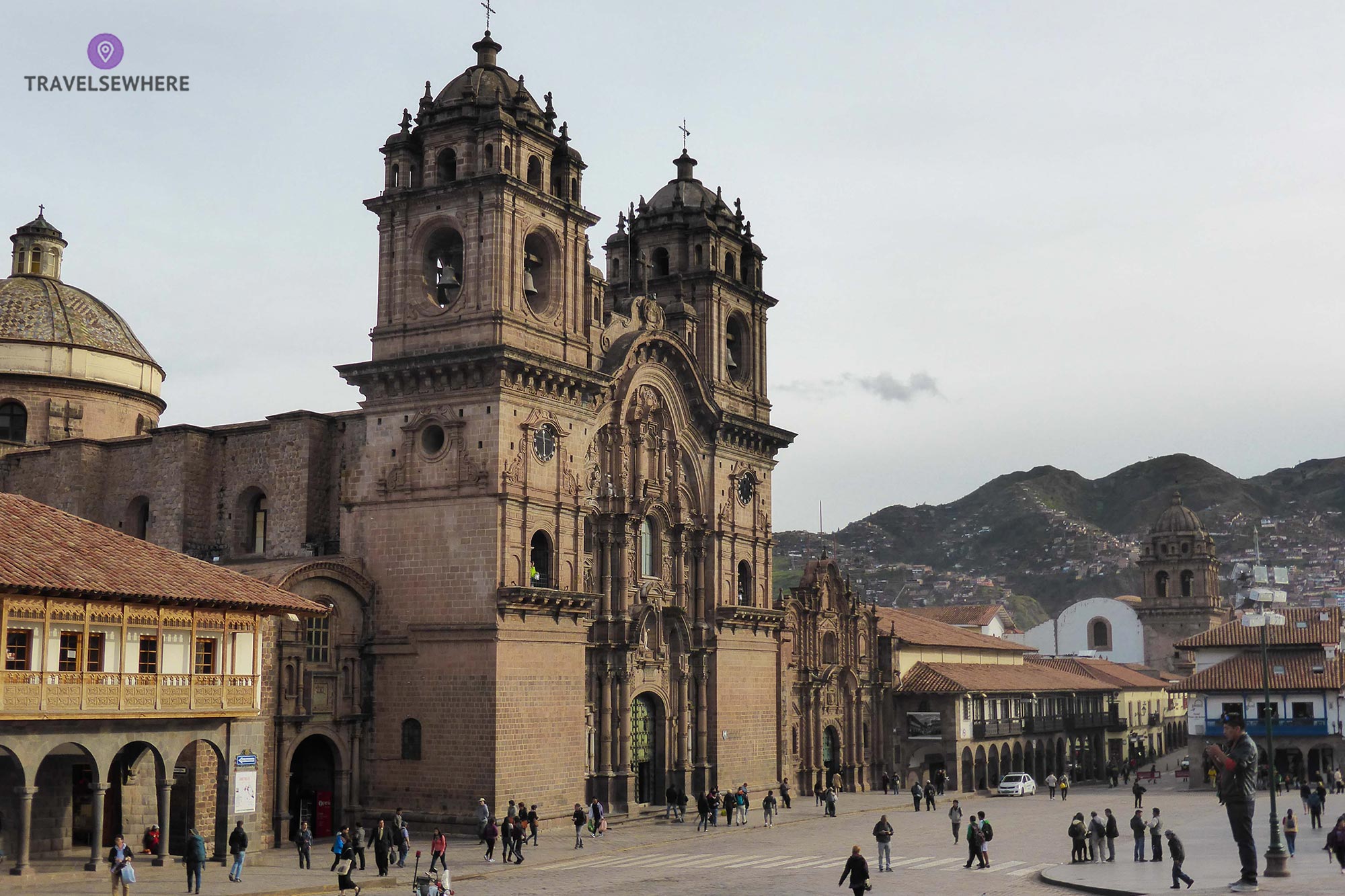
Cusco, Peru
By David, blogger always travelling elsewhere at Travelsewhere
Many people who come to the Peruvian city of Cusco do so as a starting off point for the famous Inca Trail and world wonder that is Machu Picchu. Yet, this city high in the Andes Mountains is a destination all in itself. Cusco was actually once the Incan Empire capital during the 15th and 16th centuries and today boasts a stunning blend of architecture from before and after Spanish colonisation. These amalgams of historic architecture have cemented Cusco’s place on UNESCO’s World Heritage List.
For admiring the city’s architecture, there’s no better place to start than the main square of Plaza de Armas. It is here that you’ll find impressive Baroque churches like the Cusco Cathedral and the Church of the Society of Jesus, the latter of which is built over an Incan palace.
Interestingly, as a region prone to earthquakes, it is thanks to their underlying Incan architecture that many of Cusco’s historical buildings are still standing. Even the square of Plaza de Armas lies atop the remains of Haukaypata, the Great Inca Square. Further exploring the city’s historic centre you will come across other Incan remnants such as the Twelve Angled Stone a remarkable feat of Incan Masonry and Qorikancha, a 15th century Incan Sun Temple.
Cusco offers the unique opportunity to explore the merging of two civilizations, while surrounded by the conveniences of city life. A real must when visiting Peru.
5. Angkor – Cambodia
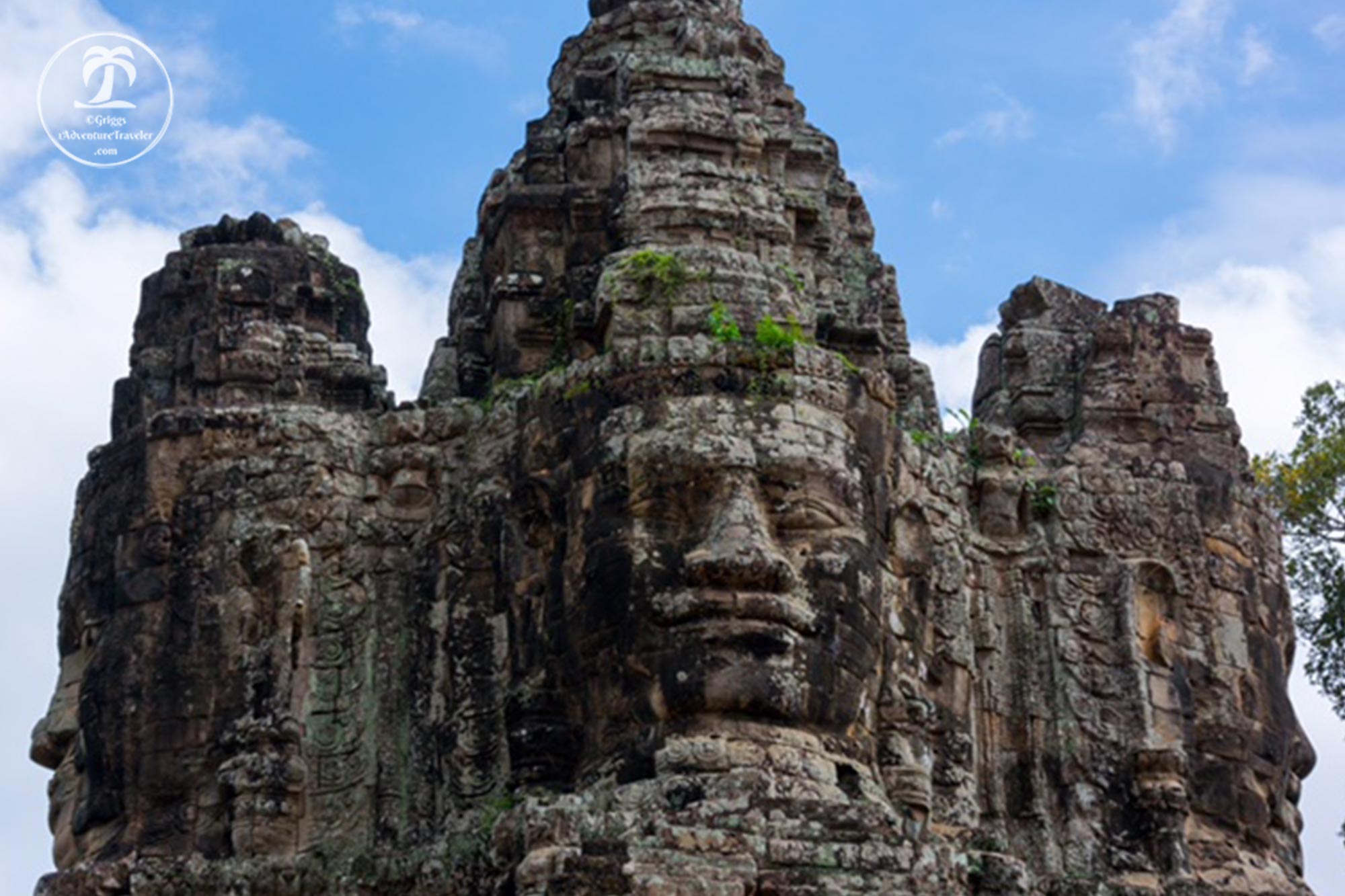
The faces of The Bayon Temple, Angkor, Cambodia
By Stephanie from 1AdventureTraveler, an Expat Adventure Traveler.
Angkor a UNESCO World Heritage Site, located in Siem Reap, Cambodia, is a magical place to visit. It is one of the more important Archaeological Sites in Southeast Asia. Let us hop on a Tuk Tuk, go through the gates and feel the magic.
Angkor is uninhabited, dates back through the 9th and 15th Century which included different capitals. The temples were constructed of stones, from a dozen different Khmer cities and were built and rebuilt during that time. Now, some of the temples are sadly reduced to ruble. On my last visit, it was wonderful to see different countries provide funds and assistance to help restore some of these temples to their mighty glory.
Angkor is the name for all the Temples within 400 square kilometers. Three days will give you time to visit the major Angkor Temples: Angkor Wat, Angkor Thom, Bayon, Banteay Srei, and Ta Prahom. Arrive early by Tuk Tuk or bicycle to catch the amazing sunrise over the temples and have a mystical experience. Walk down halls where elephants once stood and see the beautiful colorful pictures drawn on the walls. View the green rolling fields, see the canals that were built many years ago and image the people who once roamed the Angkor Temples.
To learn more about these major temples and for travel tips visit Angkor Wat an Expat Travel Adventure and Cambodia Tourism. Do not miss out on this wonderful adventure, visit Angkor.
6. Bath – England
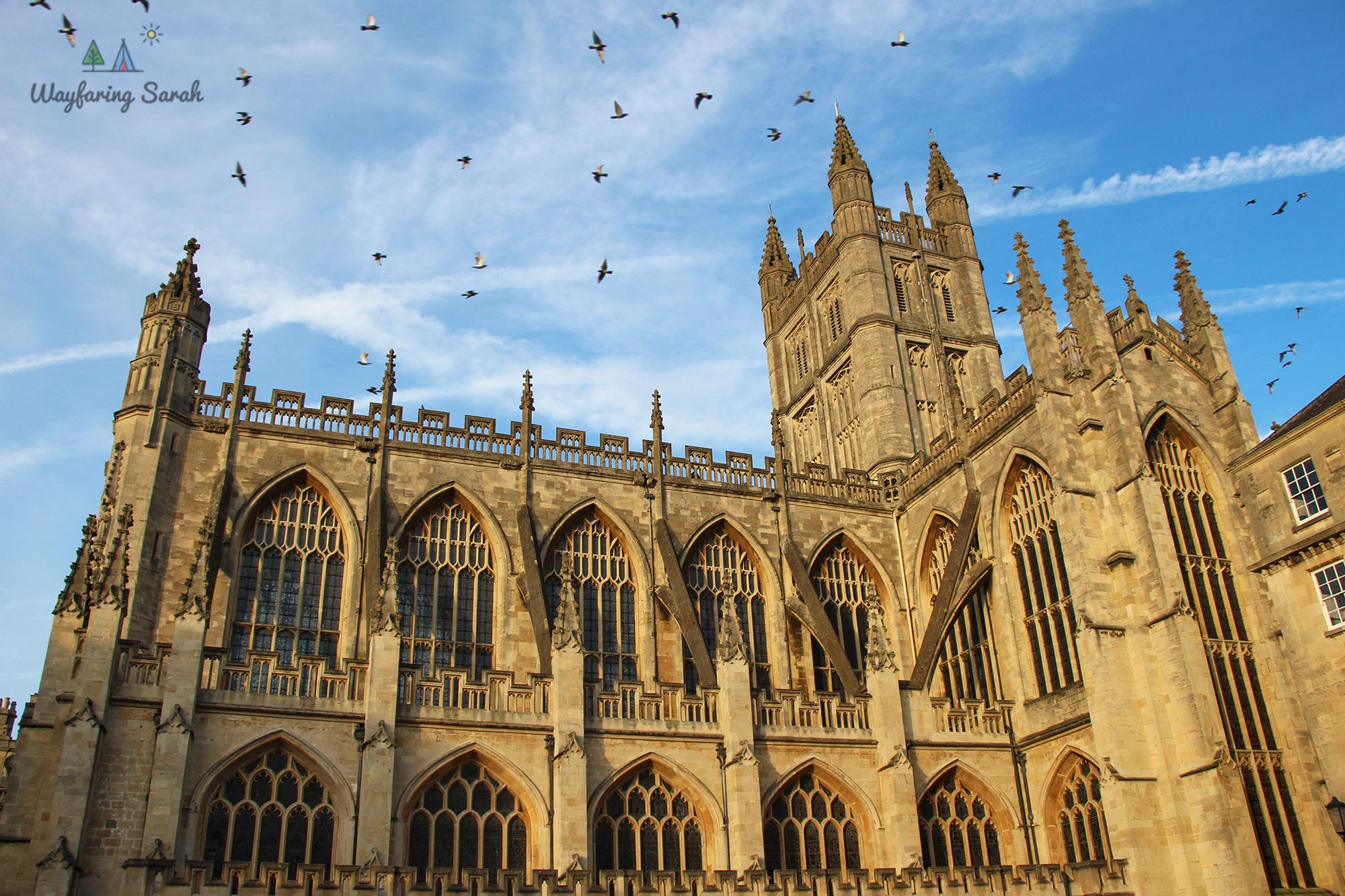
Bath Abbey is a 15th-century masterpiece that lies in the heart of the city
by Wayfaring Sarah, the chronically ill travel blogger on a mission to see the world!
Throughout history, the city of Bath has been a prolific part of the UK. Discovered by the Romans, the geothermal waters of the area soon transformed into naturally heated spas and baths – hence the name! The region continued its trajectory of luxury and developed into a stunning 18th-century town, awash with breathtaking Palladian architecture.
The neoclassical style is beautifully reminiscent of the Georgian era and remains perfectly persevered after all these years. The buildings are each designed to compliment the original Roman Baths, which still stand in the center as the crowning jewel. Today, you can visit the original spas or pamper yourself in the modern Thermae complex next door.
Bath was also home to literary hero, Jane Austen. Fans of the books will find great delight in walking around streets that could have been plucked straight from her novels. The Jane Austen Center tells her story, and Regency actors truly bring the tale to life. They can even often be spotted wandering the city in full costume – an event that only solidifies the historical aura!
Friends have often met me with confused looks when describing Bath, with great enthusiasm, as ‘beige and uniform.’ However, it is this dedication to preserving, ensuring all new developments are in keeping with its authentic style, which has earned this city its deserved status as a UNESCO heritage site!
7. Mesa Verde – USA
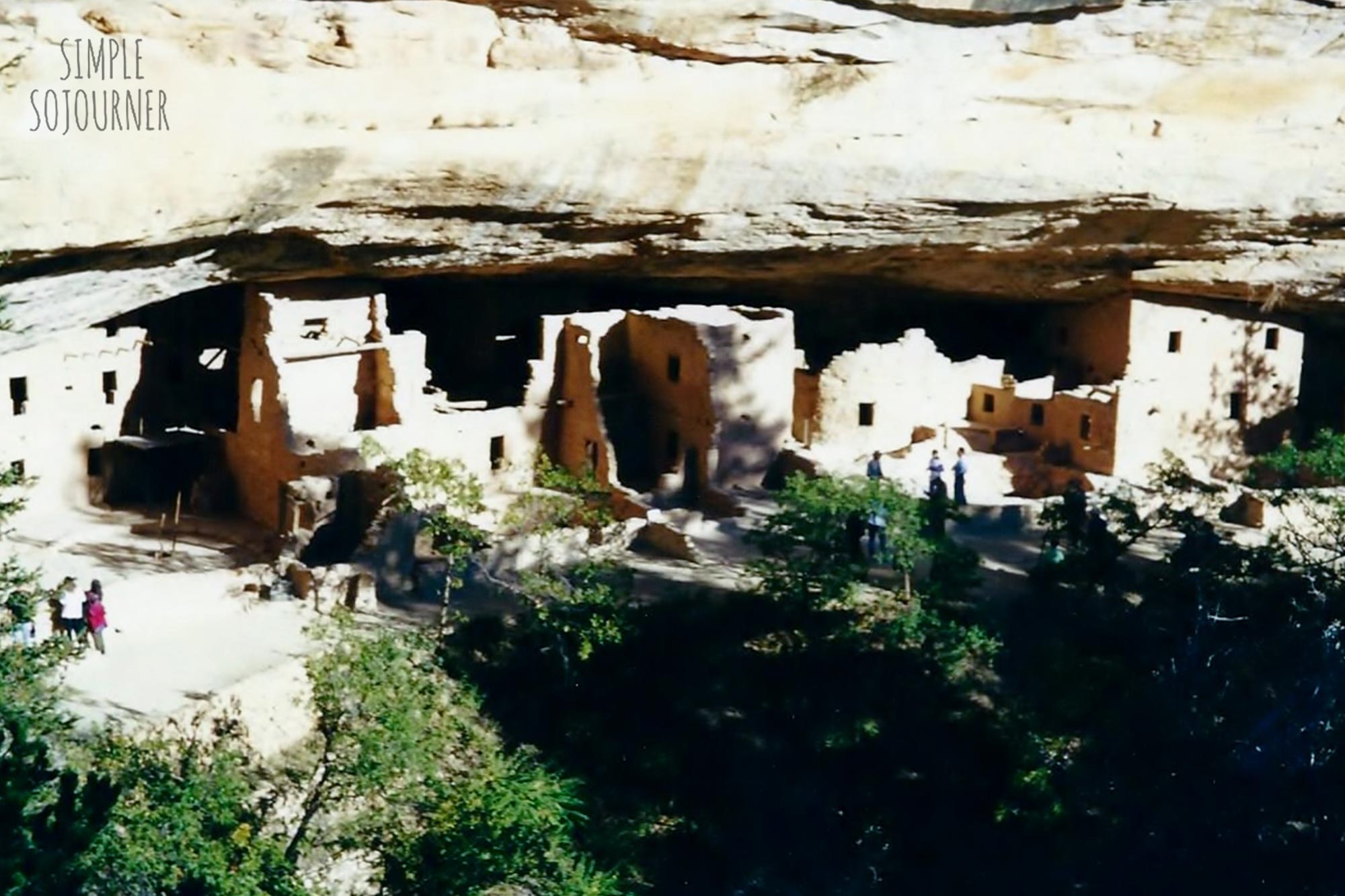
Cliff Palace, Mesa Verde, Colorado, USA
By Lisa from Simple SoJourner – The simpler side of travel
Mesa Verde located in Southwest Colorado is a unique mix of archeology and geology centered around the ancient Puebloan culture and traditions. Mesa Verde became a designated UNESCO World Heritage site in 1978 to preserve its more than 600 cliff dwellings and over 4,000 archeological sites built and inhabited by the Pueblo people.
Surrounded by 52,000 acres of gorgeous canyons, mountains, and plateaus, Mesa Verde has some of the most exceptional examples of well- preserved cliff dwellings and house alcoves that you will find anywhere in the world. Dwellings made of sandstone and mud, some with over 200 rooms including kivas (ritual quarters), store rooms, and elaborate courtyards and. Painted and inscribed murals not only can be seen in the dwellings, but also throughout the rugged landscape on rock walls. The artifacts uncovered have given us great insights into how these ancient people lived, hunted, and farmed in this area for approximately 700 years. This area is also home to abundant wildlife and rare flora found nowhere else in the country. Scenic winding roads take you to all the all the park highlights and miles of hiking trails with stunning views.
The park is now under the direction of the Archaeological Site Conservation Program to maintain and protect the area from constant erosion and wildfires which have destroyed some of the parkland and a few of the archeological sites.
This is not only an ideal National Park to visit for its sheer beauty, it’s a superb learning experience and voted best cultural attraction in the Western United States.
8. Old Havana – Cuba
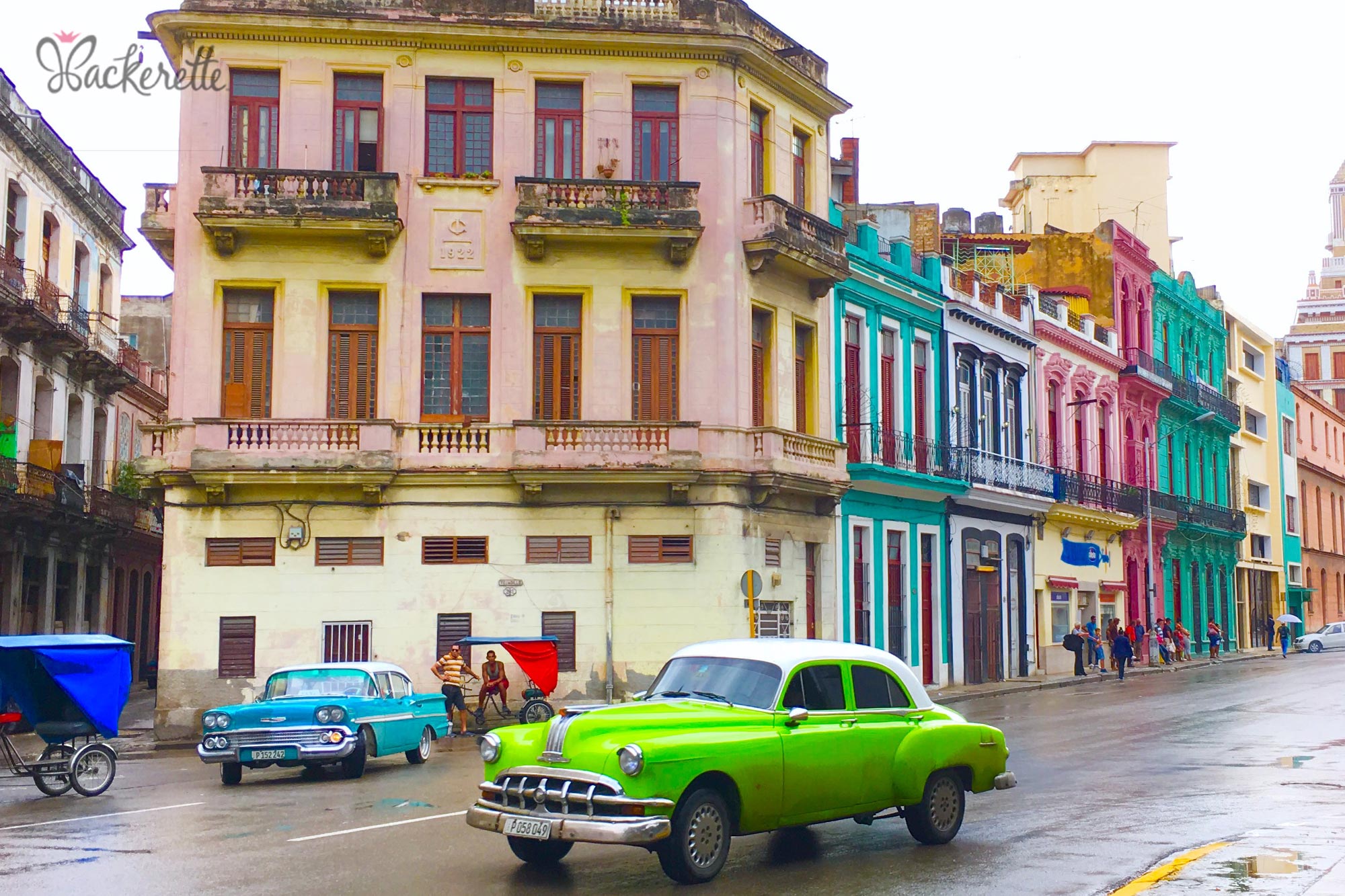
Old Havana, Cuba
By Kamelia, Bucket List Lifestyle coach from Hackerette
Old Havana is on the UNESCO World Heritage list and is now a little easier to get to with the recent changes to travel laws in 2016. Traveling to Old Havana is a little like taking a trip back in time. Classic cars zip past as you roam the streets admiring the vibrant colorful architecture.
You can start your day by enjoying the best coffee in all of Havana at a quaint little cafe called El Dandy Bar y Galeria. You’ll feel as if you’re right at home in your grandmother’s cozy living room. Next, grab a coco cab, tuk tuk or jump in a vintage taxi to explore the sights with a local guide. There is plenty to see and you’ll want to make sure you cover it all.
Havana is very safe and is easily walkable if you have the time to wander. Just make sure to trace your steps since your GPS won’t likely work. The Internet in Havana is scarce so you’ll want to have a good idea of where you are headed. If you hire a driver, make sure to negotiate the price before getting in. Have them take you to the 8km seawall known as “Malecon”. It’s the perfect place to catch a sunset with someone special before heading out for the night. Grab a daiquiri at Ernest Hemingway’s favorite haunt, El Floridita, or enjoy some local music while sipping a mojito at La Bodeguita del Medio. End the night at Fabrica de Arte Cubano (FAC) for an eclectic mix of art exhibits, live entertainment, tapas & cocktails.
9. Singapore Botanic Gardens

Orchids in Singapore’s National Orchid Garden
By Laura and Juan Pablo from CoupleTakes – An academic couple taking on the world and writing about it from dual perspectives
The Singapore Botanic Gardens are a must visit attraction for anyone spending time in the Southeast Asian city-state. Over 150 years old, the Botanic Gardens offer a beautiful oasis in their surrounding highly developed urban stomping grounds. The Gardens are free to the public (although there is a small fee to enter the National Orchid Garden exhibit within), and are conveniently located a mere five minutes away from the famous Orchard Road. This convenient location allows easy access via public transit, car/taxi, or tourist shuttles.
The Singapore Botanic Gardens are renowned for cutting edge work with orchids, and were the inspiration for Singapore’s nickname as the “Garden City.” The Gardens span some 82 hectares (202 acres), and offer something for everyone. Some of the main attractions within the Gardens include the famous National Orchid Garden; a section of rainforest that predates the Gardens; a bonsai garden; a sun garden featuring arid climate plants; a heritage museum; and a botany center hosting (among other things) a visitor center, a function hall, the orchid breeding laboratory, an herbarium, and a library of botany and horticulture.
Suitable for all ages, visitors could easily spend a whole day (or more!) visiting the attractions, dining, and shopping throughout the Gardens. Plan ahead to attend frequent events like guided tours, educational events, or plant sales. Also, don’t forget to dress in light clothing, and always carry an umbrella – you never know when a storm will roll through in Singapore!
10. Chichen Itza – Mexico
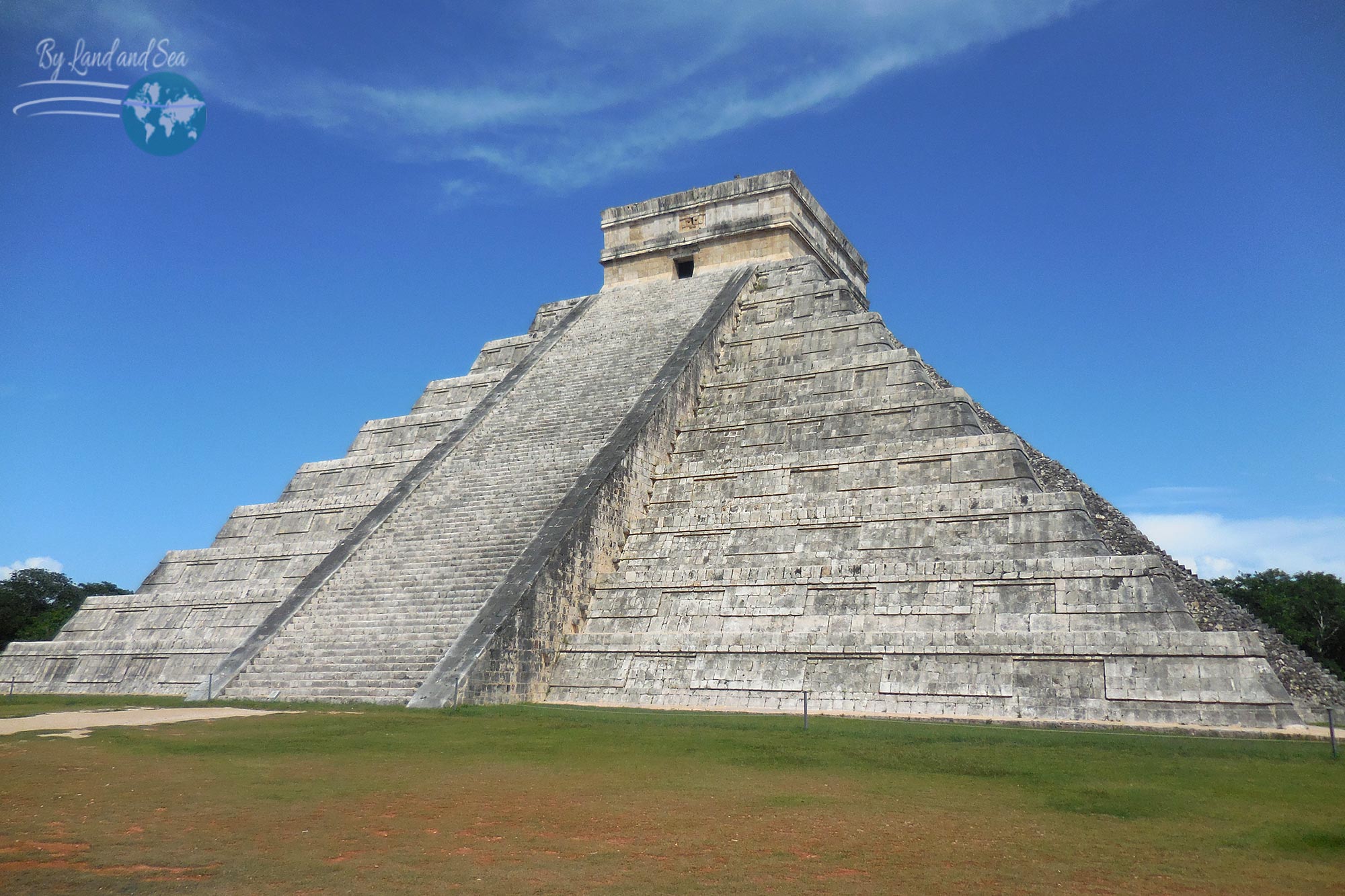
Chichen Itza, Mexico
By Jenn, half the By Land and Sea duo, exploring the world through affordable luxury, and sustainable travels.
Spending a day in Chichen Itza will take you back in time through dense jungles to the world of the ancient Mayans. It’s a world of incredible genius, astronomy, worship, and human sacrifice. Getting there involves a long drive into the jungle which goes as far as the eye can see. Once you get close to the site, make sure to stop at one of the many beautiful cenotes in the area, such as Il-Kil. Peering over the edge, through the vines, and down into the sink hole is mythical as this was the site of large amounts of human sacrifice. But, don’t let that stop you from jumping into the water to cool off before making your way to Chichen Itza!
Thousands of years ago, Chichen Itza was a major metropolis and the center of Mayan culture. It is spectacular and, as a result, its Mexico’s most visited ancient site. It is also one of the original Seven Wonders of the World, as well as a UNESCO World Heritage Site. Not only did the pyramid’s, El Castillo de Kukulcan, design serve as a calendar for the ancient people, but if you visit on either the spring or fall equinox, the afternoon shadows actually creating a moving serpent that slithers down the pyramid’s steps! The rest of the grounds include the Great Ball Court, the Columns of the Temple of a Thousand Warriors, and many other temples, structures and ruins. A day spent here is a day spent transported and transformed.
11. San Antonio Missions – USA
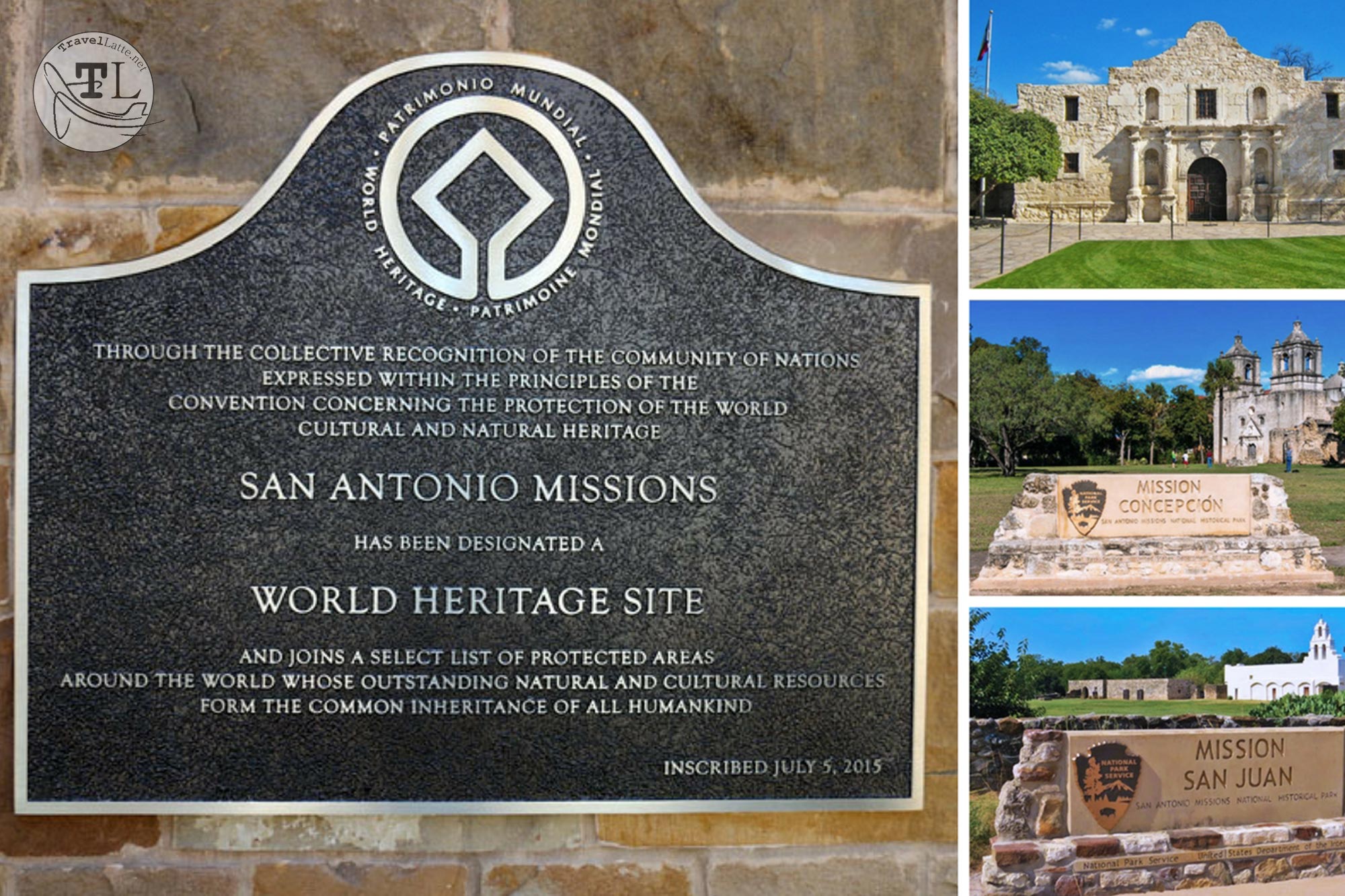
Comprised of five missions and a ranch, the Missions of San Antonio is the first UNESCO World Heritage site in Texas
By Rob & Ann of Travel Latte Pretirement travelers seeking affordable luxuries.
In the early 1700s, Spain ruled the New World, where Franciscan friars established missions to govern, educate, and convert local Indians. A group of them in what is now the American state of Texas is one of the newest UNESCO World Heritage sites. The San Antonio Missions earned the designation in 2015 – the first one in Texas – encompassing five missions and a ranch.
The oldest is Mission San Antonio de Valero, famously known as The Alamo. Established in 1718, it’s best known for the Battle of the Alamo, and is operated by the Daughters of the Republic of Texas. Four other missions followed: San Jose, San Juan, Espada, and Concepcion, the oldest non-restored stone church in America. The four are still parishes of the Catholic Archdiocese of San Antonio, and part the San Antonio Missions National Historical Park.
Little known fact: the missions are responsible for introducing ranching in Texas! To be self-sustaining, the missions raised crops and cattle. At Rancho de las Cabras, you can join park rangers on free tours to learn about the legacy of mission ranches.
The Missions of San Antonio stretch along 12 miles of the San Antonio River, and can be visited in a day. The ranch is 35 miles away, near Floresville, Texas. You can visit all of them free of charge; at the Alamo, a one hour guided tour of the complex is $15pp.
12. Gunung Mulu National Park – Malaysia
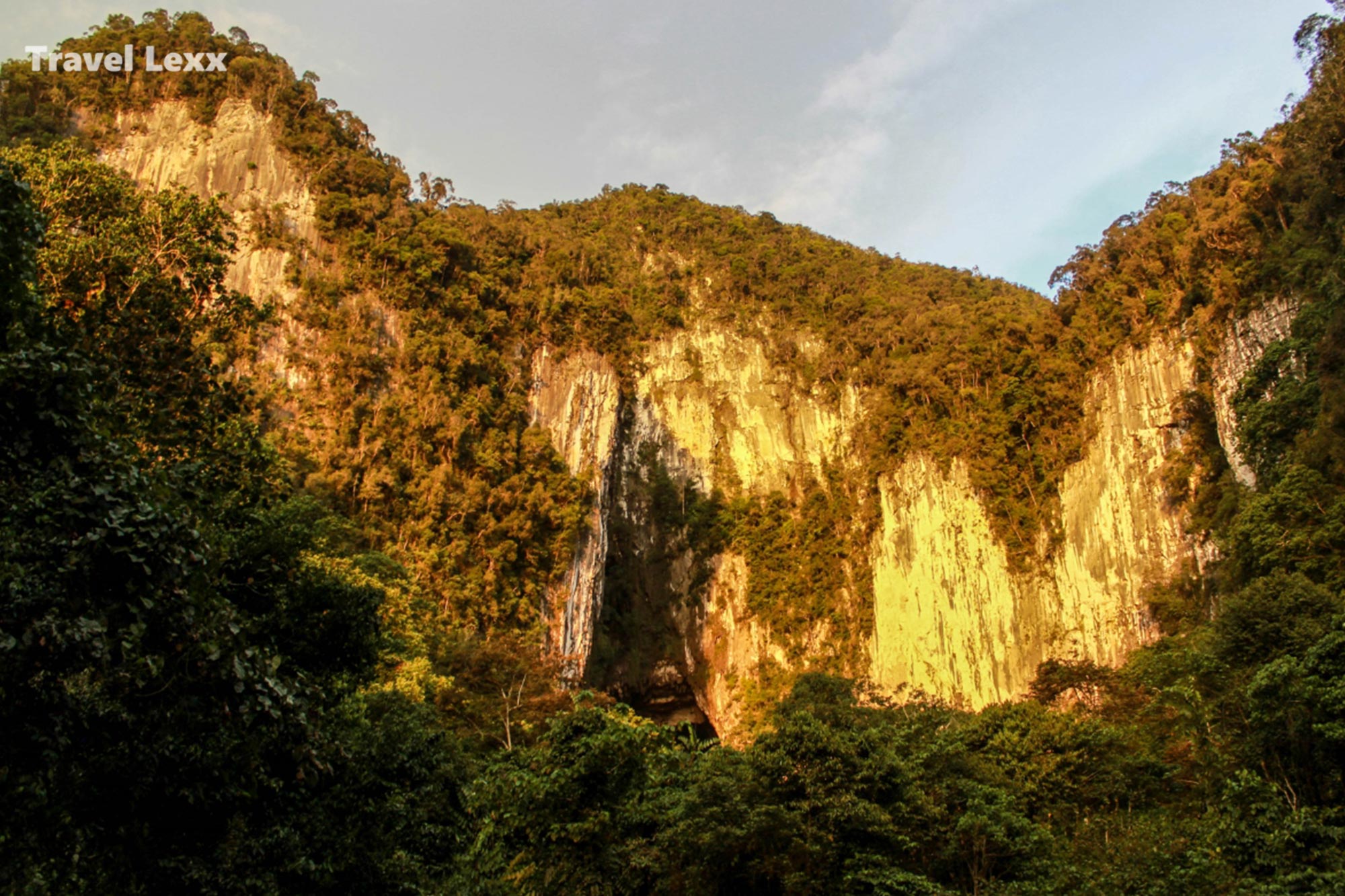
Gunning Mulu National Park
By Travel Lexx, exploring the world one active adventure at a time.
Hidden in the depths of the Bornean rainforest, Gunung Mulu National Park only reveals its treasures to the most intrepid. The park has no road access and is accessible only by plane or a chartered boat. Those that do make the trip are treated to one of Asia’s most stunning landscapes.
Huge limestone cliffs covered in dense vegetation provide a stunning backdrop with the Gunung Api mountain towering above the park. A challenging three day trek provides a unique opportunity to see giant karsts, known as The Pinnacles, clinging to its side.
Mulu is famous for its spectacular caves and is home to the Sarawak Chamber, currently the largest cave chamber in the world by area. It’s possible to discover some of these with the enormous Deer Cave one of the highlights. Walk along its ancient rock-strewn riverbed, marvelling at cascading waterfalls and limestone formations before arriving at the luscious Garden of Eden.
After exploring the cave, make your way to the clearing outside and prepare yourself for a spectacular mass exodus of millions of wrinkle-lipped bats flying out to feed while lightning-quick bat hawks take up positions on the cliff face in wait of their prey.
Spot nocturnal wildlife on guided night walks, navigate treetop canopies, hike the ominous-sounding Headhunter’s Trail or take a longboat along the Tutoh River – opportunities are endless in Mulu!
Gunung Mulu National Park World Heritage Area is accessible by a 30 minute flight from Miri with AirAsia flies from Kuala Lumpur to Miri daily (2 hours). For more information on accommodation and activities, visit the park’s official website.
13. Alberobello – Italy
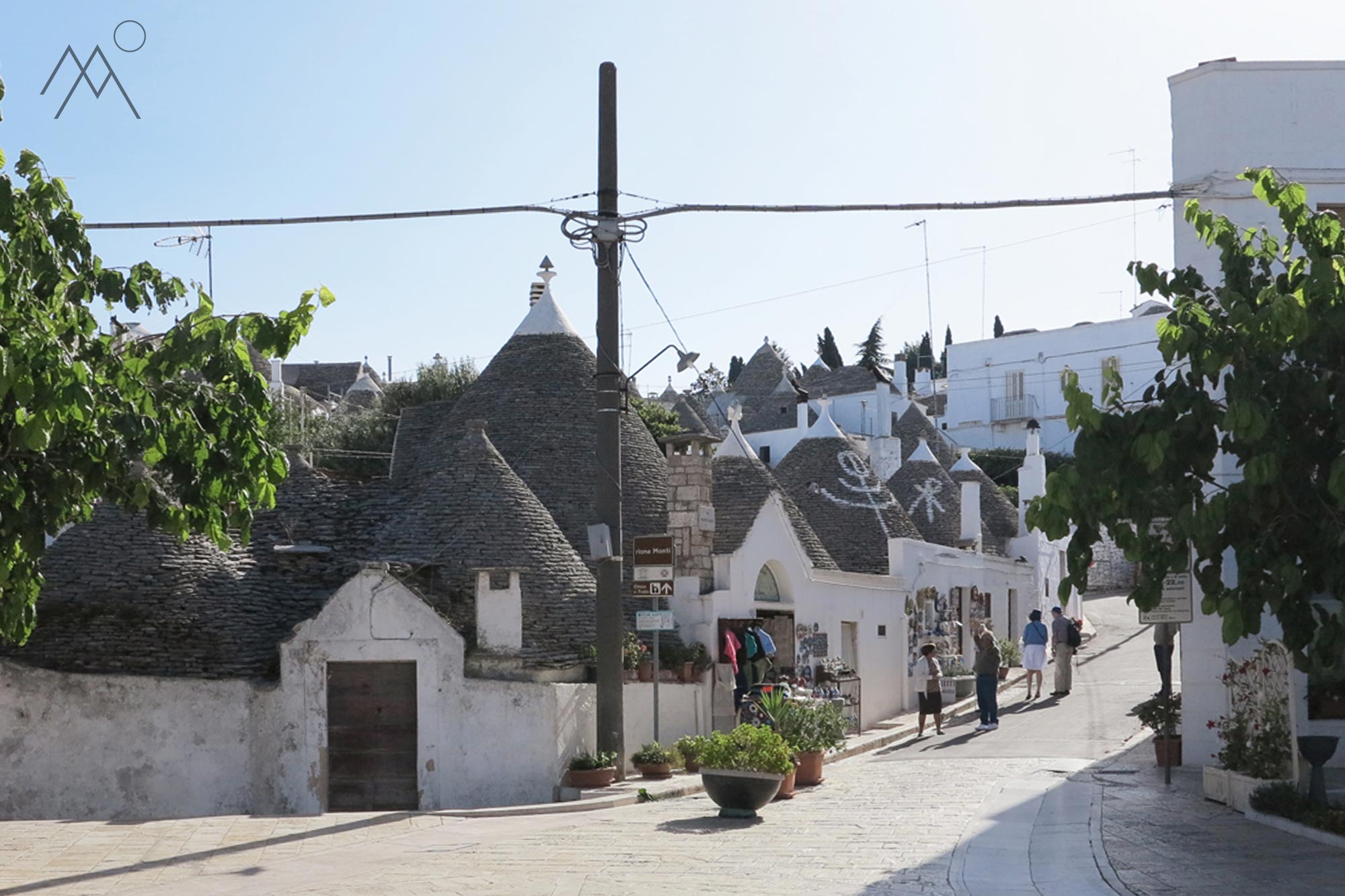
Tiny little streets of Alberobello’s historic center, Italy
By Midori Mori, the obsession’s collector behind Midori’s Obsessions
Alberobello is a magic, tiny, little town in the south of Italy, in Apulia, the ”stiletto” of Italy. All this area is beautiful and well worth a trip, specially for it’s beautiful sea and delicious food. But this town is specially wonderful and famous for its ‘trullo’, the white pyramid-shaped buildings. Alberobello is the best example of this type of construction and its historic center is entirely made up of these houses, declared in 1996 World Heritage Site by Unesco.
Alberobello’s origins date back to the Middle Age. This feud began to get populated by small farmers who wanted to reap the so-called fertile forest. Counts authorized the settlers to build their houses without cement, to be demolished if regia inspection to avoid paying the required tribute. Farmers were allowed to build these houses considered precarious and easily demolishable.
The Trullo’s vaulted ceilings were embellished with decorative pinnacles to identify families. The symbols painted on the roofs of the trulli were often used to identify the different religions of its inhabitants. Pinnacles and painted symbols together form a kind of citizen identification, useful because Alberobello was denied the official recognition by the Counts of Convers
And the best thing, is that you can sleep inside one of this beautiful buildings! We stayed at Trulli Caroli which was beautiful and at a very good price!
As you can see, Alberobello looks like something taken from Lord of the Rings or Game of Thrones, a magical place that I recommend you visiting!
14. Split with the Palace of Diocletian – Croatia
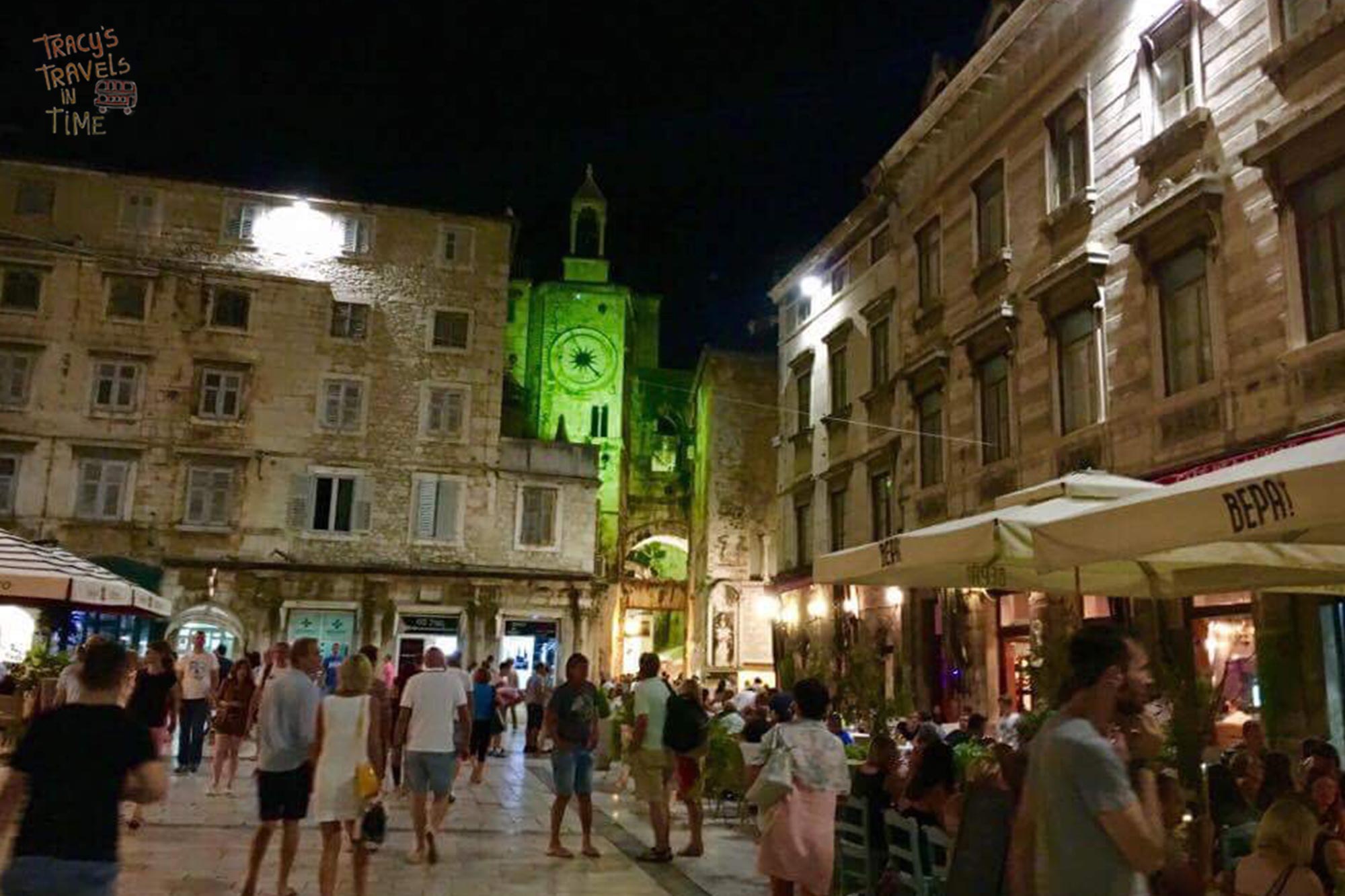
Split, Croatia. Enjoy an evening promenade and soak up the atmosphere of this historic site
By Tracy – lover of history and culture and creator of Tracy’s Travels in Time
Prepare to fall in love and your breathe taken away. As dramatic as that sounds I guarantee that you will be left speechless when you enter the most imposing ruins of Roman times found anywhere in the world. The blend of ancient and modern will astound you.
In the most beautiful of settings – the coastal mountains behind and the beautiful Adriatic sea on its doorstep – the Palace of Diocletian was built by the Roman Emperor in the 4th century. The palace covers 38,700 square metres and is entered by 4 gates. Each gate north, south, east and west is named after a precious metal (gold, silver, bronze and iron) and upon entering you will immediately appreciate that this is a ruin with a difference! It is home to over 3000 people! Amongst the ruins there are homes and bars, shops and restaurants. Lose yourself in the narrow streets and passageways or sit in the peristyle (the main open space in the palace) and soak in the atmosphere.
Climb the bell tower of the Cathedral of St Dominus for a view of the palace and surrounding area. Descend into the substructures of the palace and find stalls selling all sorts of trinkets. Or walk the Riva – the pedestrianised zone where you can admire the Adriatic on one side and the southern façade of the palace on the other.
15. Saltaire – England
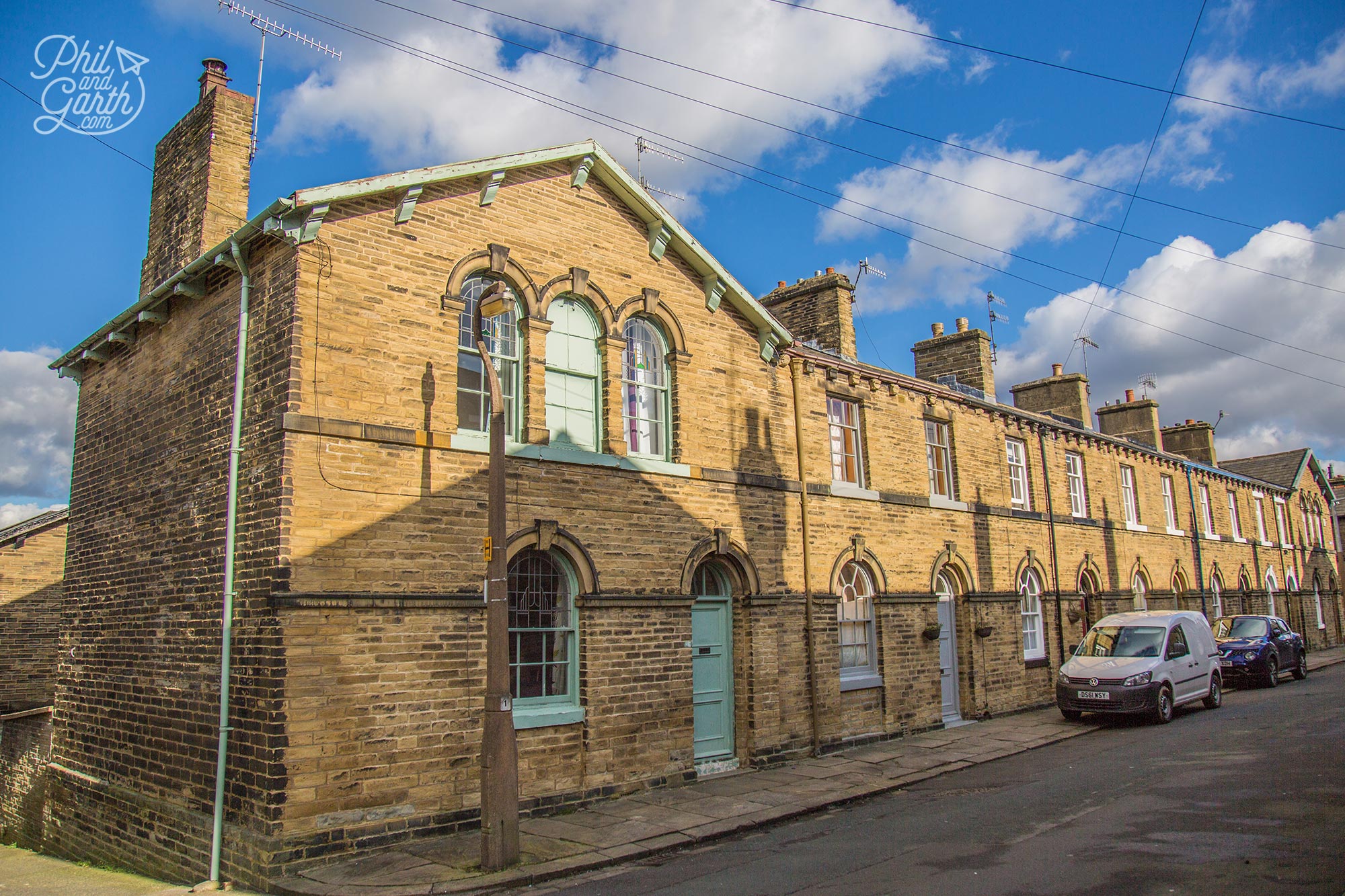
Saltaire houses near Bradford, England, UK
By Garth from Phil and Garth a couple of sightseeing & adventure travel addicts.
The town of Saltaire is a perfect example of a Victorian ‘model village’. Built in 1851 by wealthy entrepreneur and philanthropist Sir Titus Salt to house the workers of his alpaca mill, which made fine cloth and fabrics. He wanted to escape nearby Bradford, where pollution was a problem, his answer was to relocate his entire business on a grand scale and build the perfect Victorian village.
Sir Salt built grand buildings inspired by the Italian Renaissance including a church, hospital, school, a library and parks, everything to keep his workers content and healthy. The workers terraced housing was high quality and homes had water, gas, an outdoor toilet, living room, kitchen and several bedrooms, much more than they were typically used to.
Built close together on a grid pattern, this was to make best use of the land, they weren’t built too tall either to maximise daylight. Larger semi detached homes were built for Sir Salt’s company executives and community teachers, they had views of the sweeping countryside. The Salts Mill was built next to a canal to distribute goods, it was hugely impressive and became known as ‘The Palace of Industry’
All of the streets were named after his children, the Queen and his architects. In 2001 Saltaire was added to the list of UNESCO world heritage sites, recognised for it’s international influence on town planning and as an exceptionally preserved ‘model village’ in the world. Today the Salts Mill houses the world’s largest collection of art by locally born artist David Hockney.






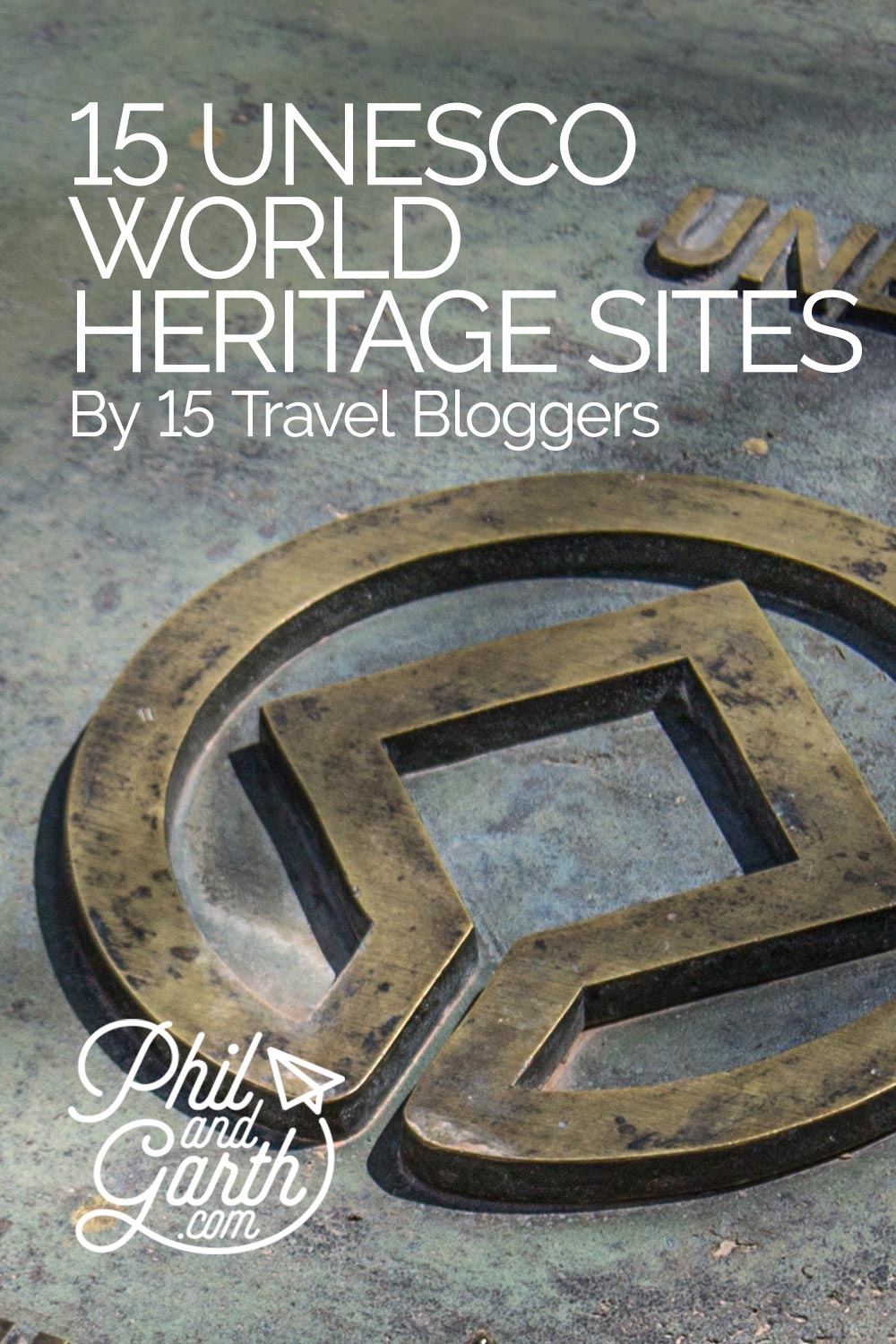
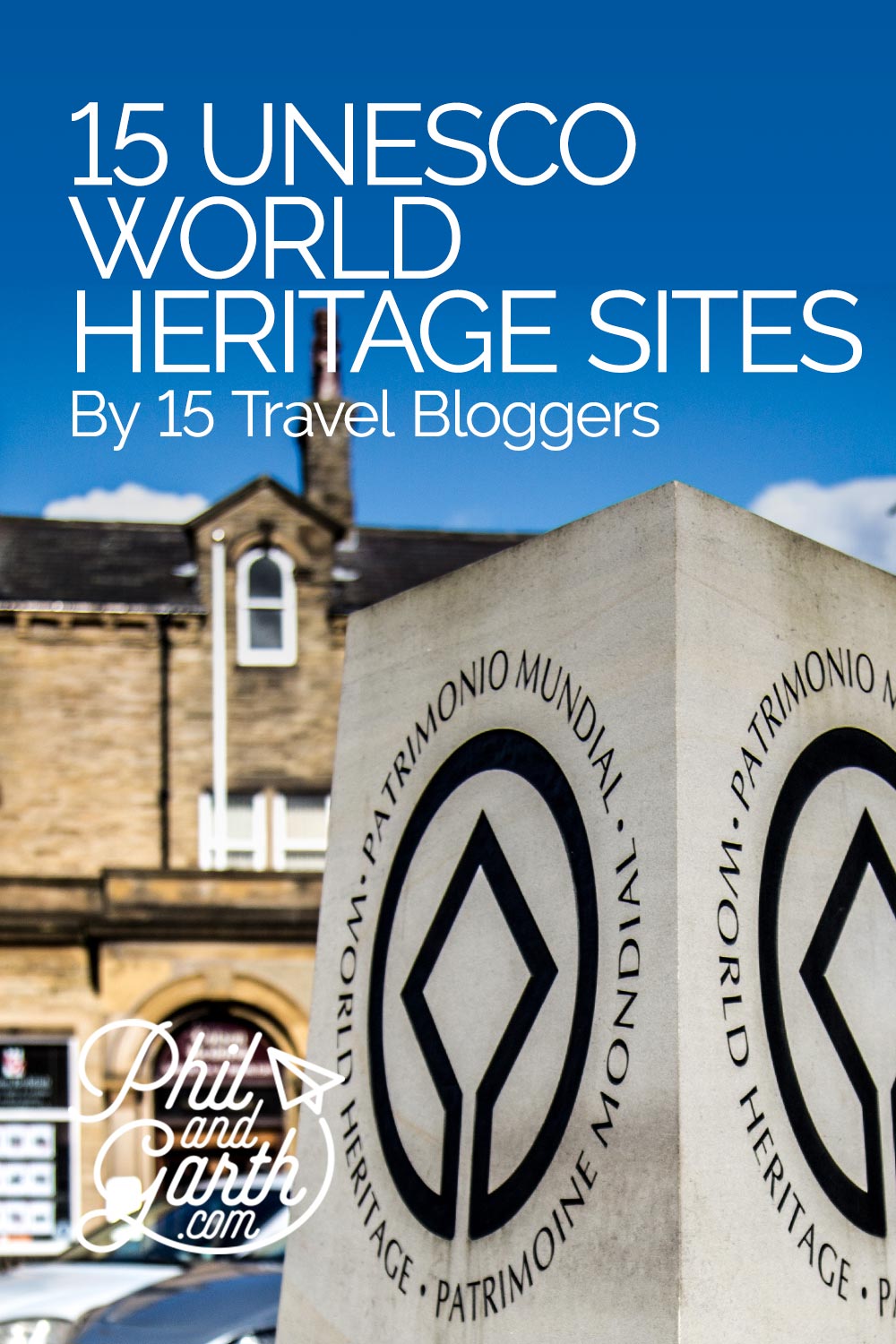
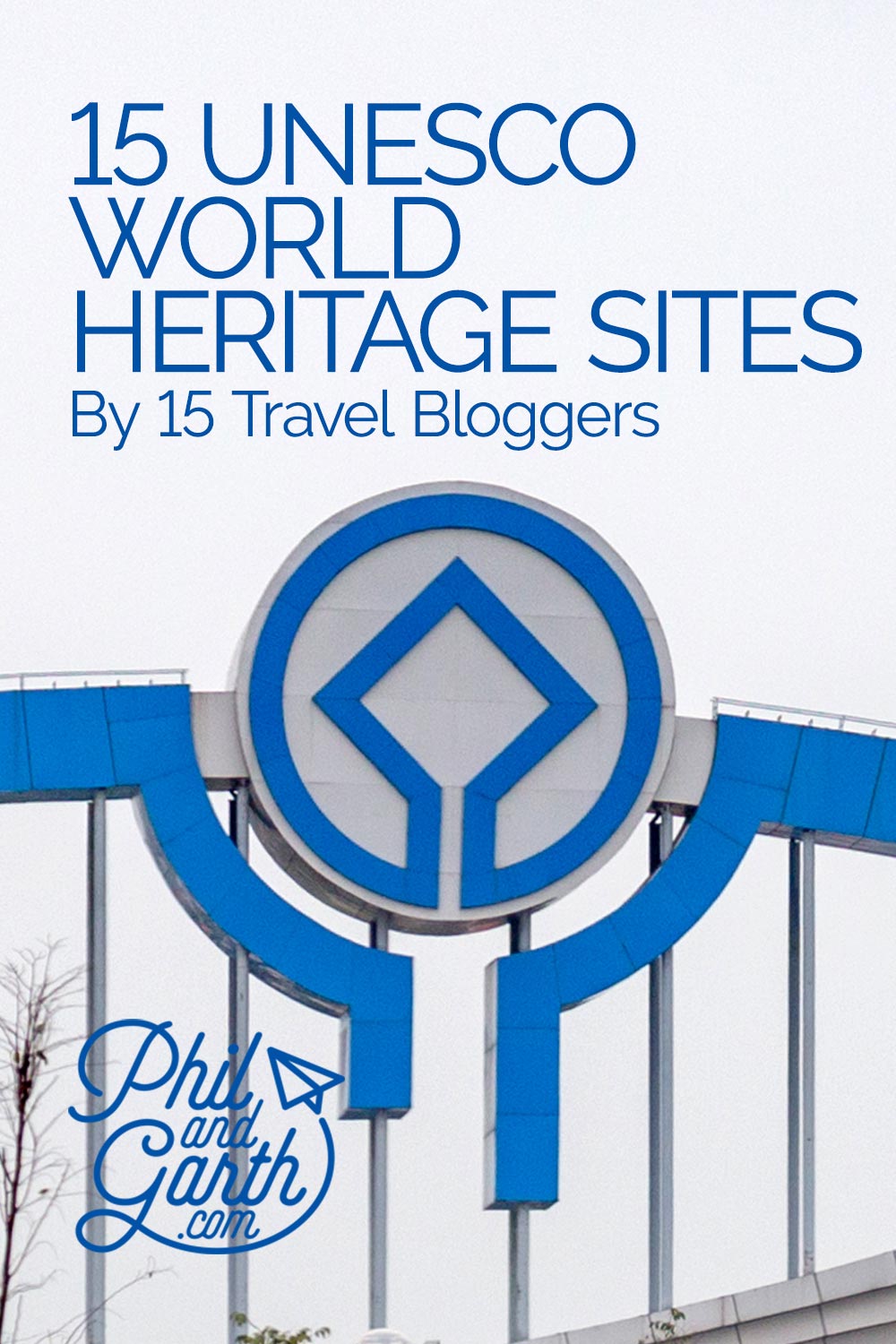
21 comments
What a great post! I always try and visit a UNESCO world heritage spot on holidays if I can. Been to a few on the list but may need to add Penang to it now! My last UNESCO site was Angkor Wat and I’ve got two coming up in Vietnam next month 😉
Awesome list! I have never been purposely travelling to a place because it’s a unesco site and there for have only visited Bath from this beautiful list. And that place blew me away! I think I might have to start looking into this more. I would have loved to see the Old Town of Tallinn in the list too, but somehow I always miss these collaboration posts haha! Well done everyone!
Such an awesome list – there is an incredible variety of UNESCO sites around the world and this is such a great taster. Gotta add a LOT of these to my list. My aim is to see as many UNESCO sites as I can! Thanks for a great post!
Fantastic list and a wonderful collaboration. A few I hadn’t heard of and the ones I’ve visited I want to return. Thanks for putting this together.
I’ve only been to Bath and Split and loved both cities but I’m heading to Cusco next week and cannot wait to visit. My bucket list just got longer – thanks for sharing 🙂
I love how many different places you featured here, many we didn’t know were UNESCO World Heritage Sites! There’s so many great places to visit. Thanks again for letting me be a part of your awesome collab post… I just love them!! Sharing across social media!
Excellent post and video. Lots more now added to the to do list! #feetdotravel
Awesome video and very informative post 🙂
Brilliant post. I have visited just 2 places from this list, Angkor and Bath but I am planning to tick off my list more in 2017. Thank you for putting this together.
I’ve only been in Teotihuacan (which is absolutelly amazing!) and now I’m dreaming of Cusco, Angkor and Bath! I didn’t know about Bath, but looks so beautiful!!!! Thank for chosing my suggestion! <3